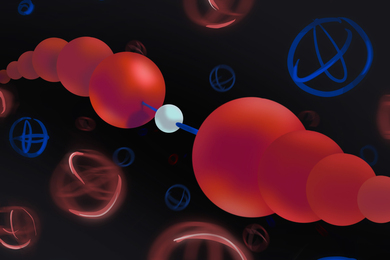MIT’s research community had another year full of scientific and technological advances in 2024. To celebrate the achievements of the past twelve months, MIT News highlights some of our most popular stories from this year. We’ve also rounded up the year’s top MIT community-related stories.
- 3-D printing with liquid metal: Researchers developed an additive manufacturing technique that can print rapidly with liquid metal, producing large-scale parts like table legs and chair frames in a matter of minutes. Their technique involves depositing molten aluminum along a predefined path into a bed of tiny glass beads. The aluminum quickly hardens into a 3D structure.
- Tamper-proof ID tags: Engineers developed a tag that can reveal with near-perfect accuracy whether an item is real or fake. The key is in the glue that sticks the tag to the item. The team uses terahertz waves to authenticate items by recognizing a unique pattern of microscopic metal particles mixed into the glue.
- Chatting with the future you: Researchers from MIT and elsewhere created a system that enables users to have an online, text-based conversation with an AI-generated simulation of their potential future self. The project is aimed at reducing anxiety and guiding young people to make better choices.
- Converting CO2 into useful products: Engineers at MIT designed a new electrode that boosts the efficiency of electrochemical reactions to turn carbon dioxide into ethylene and other products.
- Generative AI for databases: Researchers built GenSQL, a new generative AI tool that makes it easier for database users to perform complicated statistical analyses of tabular data without the need to know what is going on behind the scenes. The tool could help users make predictions, detect anomalies, guess missing values, fix errors, and more.
- Reversing autoimmune-induced hair loss: A new microneedle patch delivers immune-regulating molecules to the scalp. The treatment teaches T cells not to attack hair follicles, promoting hair regrowth and offering a promising solution for individuals affected by alopecia areata and other autoimmune skin diseases.
- Inside the LLM black box: Researchers demonstrated a technique that can be used to probe a large language model to see what it knows about new subjects. The technique showed the models use a surprisingly simple mechanism to retrieve some stored knowledge.
- Sound-suppressing silk: An interdisciplinary collaboration of researchers from MIT and elsewhere developed a silk fabric, barely thicker than a human hair, that can suppress unwanted noise and reduce noise transmission in a large room.
- Working out for your nervous system: Researchers found that when muscles work out, they help neurons to grow as well. The findings suggest that biochemical and physical effects of exercise could help heal nerves.
- Finding AI’s world model lacking: Researchers found that despite its impressive output, generative AI models don’t have a coherent understanding of the world. Large language models don't form true models of the world and its rules, and can thus fail unexpectedly on similar tasks.










